
table of contents
- Primrose species with heights of up to ten centimeters
- Heights up to 20 centimeters
- Heights up to 30 centimeters
- Heights up to 45 centimeters
- Heights up to 60 centimeters
- Heights up to 130 centimeters
- frequently asked Questions
There are around 500 different primrose species worldwide, a small number of which are native to Germany. For the simplified purchase decision, the following is an overview, sorted according to the respective height of growth.
In a nutshell
- most primrose species are small
- mostly spring bloomers
- Whether for tubs, pots or garden beds - the right primroses are available for every need
- Primroses also known as cowslips
Primrose species with heights of up to ten centimeters
Pillow cowslip (Primula x pruhoniciana)
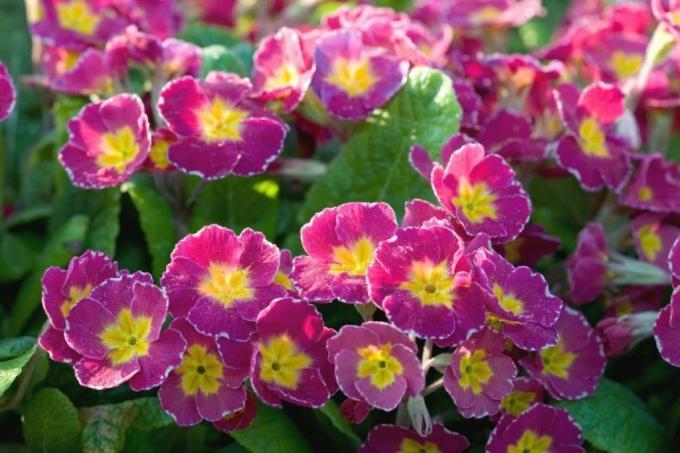
- Growth: cushion-like and forming
- Spread: 15 to 20 centimeters
- Height: four to eight centimeters
- Flower: plate-shaped
- Flower color: white, purple
- Flowering period: March to April
- Soil: loamy-sandy, rich in humus
- Location: sun to partial shade
- Special features: evergreen, ground covering
- Popular varieties: Primula x pruhoniciana 'Ostergruß', 'Snow Cushion' and 'Wanda White', which can reach a height of 15 centimeters
Rose cowslip (Primula rosea)

- Growth: rosette-like
- Spread: 15 to 20 centimeters
- Height: three to ten centimeters
- Blossom: simple, umbel-shaped
- Flower color: mainly pink and red tones
- Flowering period: March to April
- Soil: likes boggy, loamy-sandy, humus-containing
- Location: sun to partial shade
- Special features: large flowers, ideal for planting on the banks of the river, deciduous, slightly fragrant
- Popular variety: Primula rosea 'Gigas' with purple-red flowers
Stemless cowslip (Primula vulgaris)
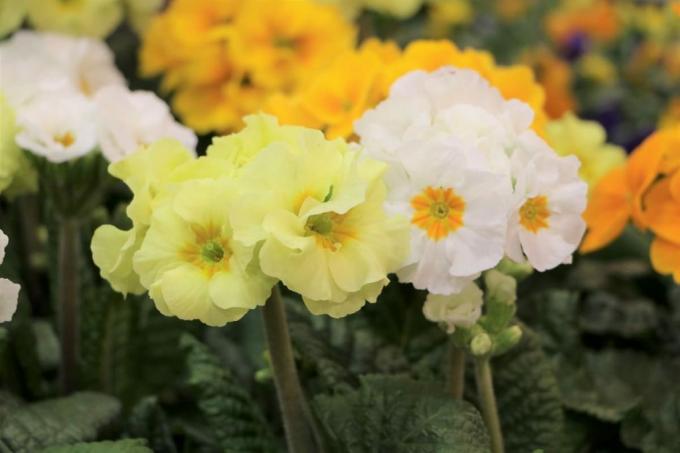
- Growth: rosette-like and cushion-like, clump-forming
- Spread: 15 to 20 centimeters
- Heights of growth: between three to eight centimeters
- Flower: simple, cup-shaped
- Flower color: purple, yellow, orange, red, pink, white, multicolored
- Flowering period: March to April
- Soil: loamy and sandy, rich in humus, fresh
- Location: partial shade
- Special features: evergreen, pleasantly scented, is one of the smallest and best-known primrose species
Carpet primroses (Primula juliae)
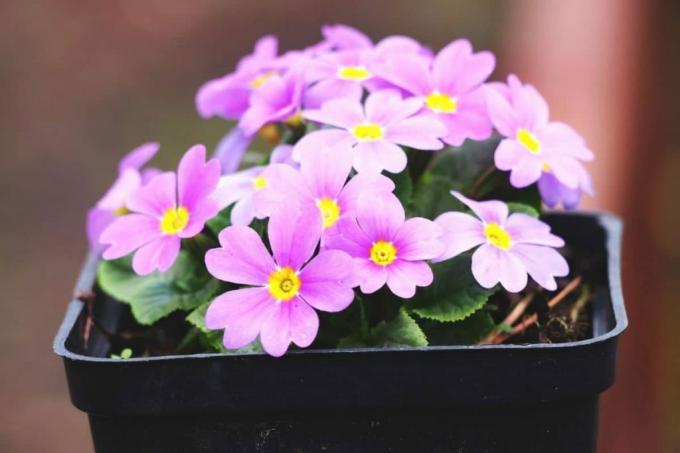
- Habit: creeping, ground covering
- Spread: 2.5 to five centimeters
- Height: five to ten centimeters
- Flowering: simple
- Flower color: depending on the variety, purple-red to mauve-blue, yellow center of the flower
- Flowering period: February to April
- Soil: permeable, moist, does not tolerate waterlogging, pH value: acidic to neutral
- Location: partial shade
- Special features: perennial, hardy
- Popular varieties: 'Blue Horizon' with purple flowers, 'Wanda' with pink flowers, light blue 'Blue Julianas'
Heights up to 20 centimeters
Alpine auricle (Primula x pubescens)

- Growth: upright, rosette-like, clump-forming
- Spread: 20 to 25 centimeters
- Height: 15 to 20 centimeters
- Blossom: simple, umbel-shaped
- Flower color: depending on the variety, dark violet, purple-red, white, yellow, two-colored, all with a cream-colored flower center
- Flowering period: April to June
- Soil: fresh, well-drained, poor in humus, like stony
- Location: sun
- Special features: not suitable as a container plant, evergreen, hardy
- Other popular varieties: Alpine auricle 'Nanni' in purple-red, Alpine auricle 'Alois' with a white flower, yellow center and black flower edge, Primula x pubescens 'Vroni'
Note: Almost all primrose species have poisonous plant parts. Although it is classified as slightly toxic, it should still be kept out of the reach of small children and pets.
Common cowslip (Primula veris)
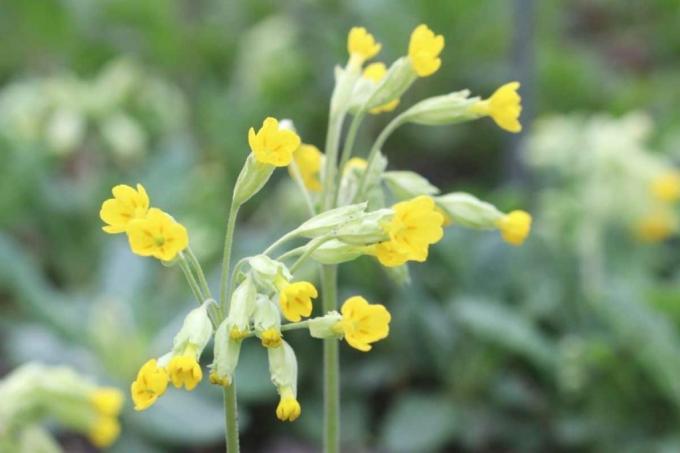
- Habit: basal leaf rosette, upright, clumpy
- Spread: 20 to 30 centimeters
- Height: ten to 20 centimeters
- Blossom: simple, umbel-shaped
- Flower color: deep yellow
- Flowering period: April to May
- Soil: dry to fresh, well-drained, rich in humus, pH value: between neutral and lime-rich
- Location: sun to partial shade
- Special features: ideal as a container plant, deciduous, has a delicate scent
- Other varieties available in different colors and with flowering time until June
High cowslip (Primula elatior subsp. elatior)

- Growth: rosette-like, upright plant stems, forming clumps
- Spread: between 20 and 30 centimeters
- Heights of growth: between ten and 20 centimeters
- Blossom: simple, umbel-shaped
- Flower color: sulfur-like yellow
- Flowering period: March to April
- Soil: loamy, rich in humus, fresh to moist
- Location: sun to partial shade
- Special features: subtly scented, deciduous, hardy
Heights up to 30 centimeters
Cup primrose / poison primrose (Primula obconica)
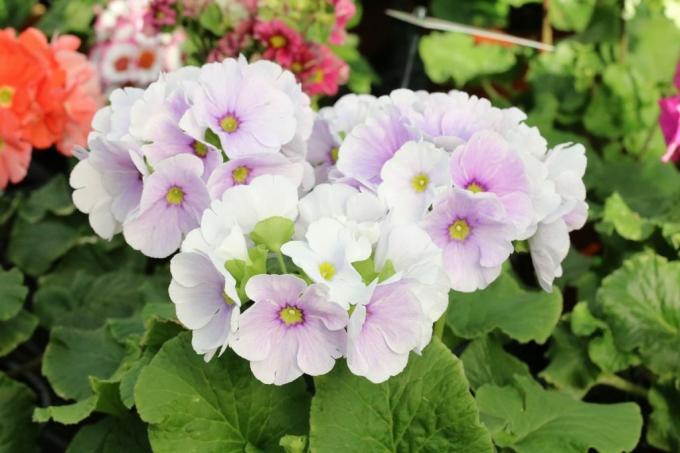
- Growth: upright, herbaceous
- Spread: 2.5 to five centimeters
- Heights up to 25 centimeters
- Blossom: umbel-like, double, single or ruffled depending on the variety,
- Flowering period: between March and June
- Flower color: white, pink or light purple
- Location: bright to shady
- Special features: very popular as a potted plant, cannot overwinter below ten degrees Celsius, one of the primrose species with the most flowers Contact allergies trigger
Ball primrose (Primula denticulata)
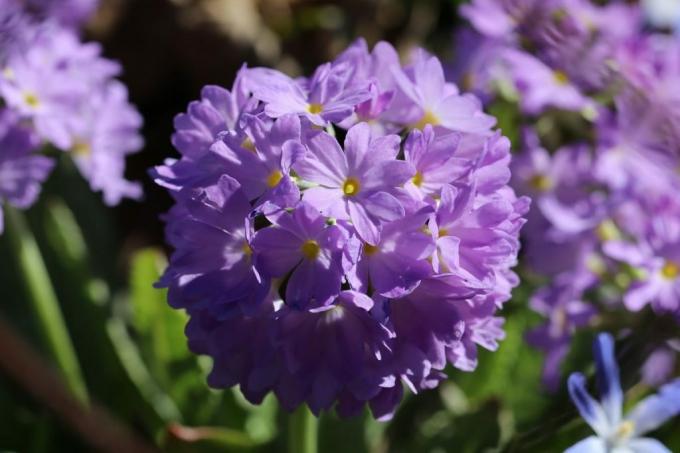
- Habit: rosette-like, spreading, clump-forming, dense, upright stems
- Spread: 15 to 20 centimeters
- Heights of growth: between 15 and 25 centimeters
- Flower: simple, ball-shaped
- Flower color: available in numerous colors
- Flowering period: March to May
- Soil: fresh to moist, well-drained, rich in humus and nutrients, preferably clay and sand
- Location: sun to partial shade
- Special features: hardy, bright white flower balls, deciduous
- Popular varieties with heights of up to 30 centimeters: Ball primrose 'Grandiflora' with violet flowers, Ball primrose 'Rubin' with deep purple-red flowers, Primula denticulata 'Alba' with white flowers
Siebold's primrose (Primula Sieboldii)

- Growth: persistent, basal, rosette-like
- Spread: three to five centimeters
- Heights of growth: between ten to 30 centimeters
- Flower: umbel-shaped
- Flowering period: between April and May
- Flower color: white, pink or red
- Soil: loose, loamy, rich in humus
- Location: partial shade
- Special features: hardy, pleasantly scented, suitable for keeping in pots
- Popular varieties: 'Cohsiboro' with purple flowers, 'Hinomaru' with flowers in carmine red, 'Miyono Homare' flowers in light pink, 'Yubi Sugata' in light blue and 'Snowflakes' with snow-white flowers
Heights up to 45 centimeters
Lilac primrose / bridal primrose (Primula malacoides)

- Growth: rosette-like
- Spread: ten to 30 centimeters
- Height: 30 to 45 centimeters
- Flowering: simple
- Flowering period: December to March, if sown in autumn, flowers from March
- Flower color: white, pink or purple
- Soil: rich in humus, loose, permeable
- Location: sunny to partially shaded
- Special features: sensitive to frost, some annual varieties, perennial varieties evergreen and sensitive to frost
Orchid primrose (Primula vialii)

- Growth: rosette-like
- Spread: ten to 20 centimeters
- Height: 30 to 35 centimeters
- Flower: spike-shaped
- Flowering period: between May and July
- Flower color: red-violet with dark red calyxes
- Soil: low in lime, well drained, fresh and rich in humus
- Location: partially shaded
- Special features: perennial, hardy, colorful flower candles
- Very popular variety: Orchid Primrose 'Red Hot Poker'
Heights up to 60 centimeters
Bunk cowslip (Primula japonica)
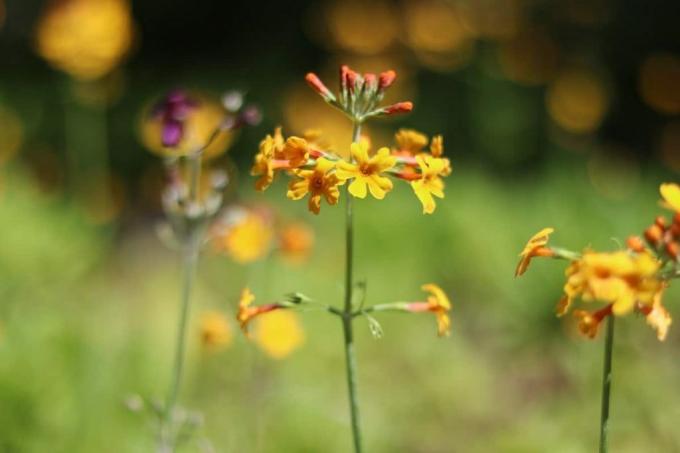
- Growth: upright, basal head
- Spread: 20 to 30 centimeters
- Heights of growth: between 40 and 60 centimeters
- Blossom: simple, umbel-shaped
- Flower color: pink, red, orange tones
- Flowering period: May to July
- Soil: rich in humus, loamy, moist, fresh
- Location: partial shade
- Special features: deciduous, hardy, ideal as a cut flower, not fragrant, suitable for water marks
- Popular varieties: Primula japonica 'Miller's Crimson' in dark purple-red with a black center of the eye, 'Appleblossom', delicate pink blooming, orange blooming 'Bulley's cowslip' (Primula bulleyana)
Heights up to 130 centimeters
Tibetan primrose / summer primrose (Primula florindae)

- Growth: upright, rosette-like, persistent, herbaceous
- Spread: 30 to 40 centimeters
- Heights of growth: between 30 and 120 centimeters, sometimes up to over 130 centimeters
- Blossom: egg to heart-shaped, funnel-shaped, drooping
- Flower color: (lemon) yellow
- Flowering period: June to August
- Soil: moist, often swampy, rich in humus
- Location: Sun, partial shade, also tolerates shade, likes it cool
- Special features: hardy, less common Summer bloomer Among the primrose species, very insect-friendly, suitable as a cut flower, hardy to minus 17 degrees Celsius, wonderfully fragrant
Note: The Tibetan / summer primroses are the only primrose species that can grow to over a meter. To do this, however, optimal site conditions and needs-based maintenance are required.
frequently asked Questions
The Tibetan primrose needs a lot of space to spread, because only then will it shoot up. Classic balcony boxes usually do not have the required dimensions to allow a Tibetan primrose to thrive to the maximum height. It would remain significantly smaller, but it would be quite viable. However, cultivation in a tub or garden bed is recommended to allow the full beauty of this primrose species to develop.
No. In the case of the small primrose species from the overview, only the withered flowers are normally cut off. Tall specimens have long flower stalks that should be cut off after the flowering period so that the plants can sprout again vigorously.
All primrose species only reach their maximum height if the soil and site conditions meet their requirements. In the overview you will find relevant information about the criteria. The need for care should also be taken into account.


